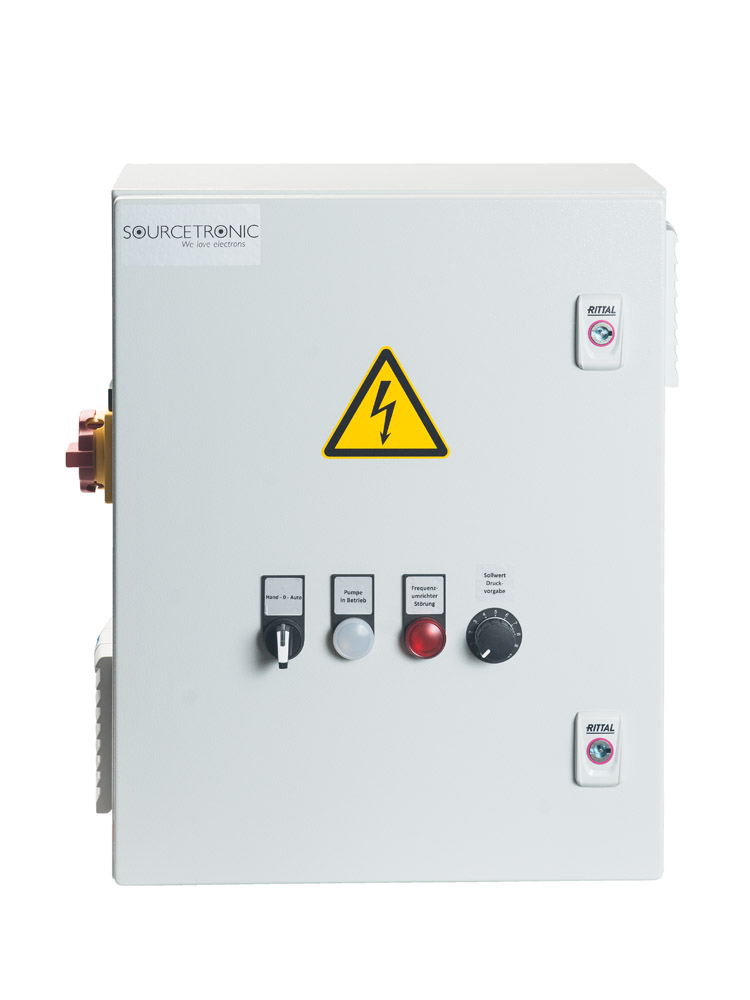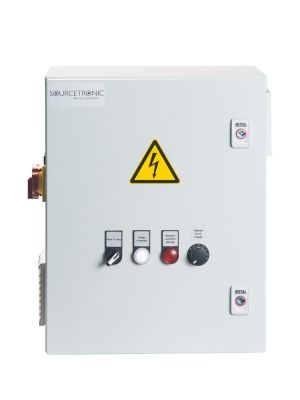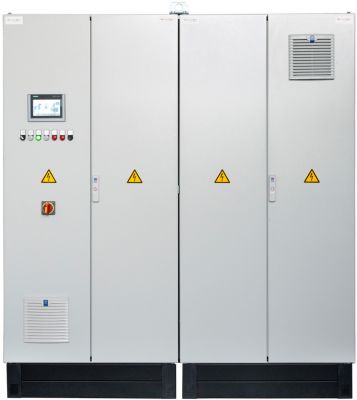Certified quality management system
Pump controls with frequency converter, configurable as desired
The pump control can be optimized by using a frequency converter. The program controlled converter will take over pump control by fitting the rotation speed control of the AC drive and with it the engine output of the pump to the circumstances. A program like this can be customized individually. This can result in a huge savings capacity of energy. The frequency inverter first transfers the power supply voltage to direct voltage in the intermediate circuit and then again into AC voltage. Afterwards the frequency is variable. Thus pressure surges can be avoided and the AC drive can run out softly.
Important information about the pump controls can be found here:
- Power: 5.5kW to 15kW, 400V
- Precise PID control with frequency converter
- Modular compact switchgear
- Switch for manual and automatic operation
- 2 x indicator lights, 1 x potentiometer
- Dry run protection & motor protection
- Pressure, level, temperature control, etc.
- Efficiency according to IE2 (up to 98%)
- Software: ST®DRIVE, ST®APP
- Control voltage: 230VAC / 24VDC
- Protection class: IP54, EN60529/NEMA4
- Additional motor protection switch
- Gentle motor choke
- Thermostat for temperature adjustment
- Power: 18.5kW to 30kW, 400V
- Precise PID control with frequency converter
- Modular compact switchgear
- Switch for manual and automatic operation
- 2 x indicator lights, 1 x potentiometer
- Dry run protection & motor protection
- Pressure, level, temperature control, etc.
- Efficiency according to IE2 (up to 98%)
- Software: ST®DRIVE, ST®APP
- Control voltage: 230VAC / 24VDC
- Protection class: IP54, EN60529/NEMA4
- Additional motor protection switch
- Gentle motor choke
- Circuit breaker
- Thermostat for temperature adjustment
- Powerful 24V auxiliary power supply
- Power: 37 kW to 132 kW, 400V
- Precise PID control with frequency converter
- Modular compact switchgear
- Switch for manual and automatic operation
- Pressure, level, temperature control, etc.
- Efficiency according to IE2 (up to 98%)
- Software: ST®DRIVE, ST®APP
- Control voltage: 230VAC / 24VDC
- Protection class: IP54, EN60529/NEMA4
- Additional motor protection switch
- Gentle motor choke
- Circuit breaker
- Thermostat for temperature adjustment
- Powerful 24V auxiliary power supply
- Power: 160 kW to 710 kW, 400V
- Precise PID control with frequency converter
- Modular compact switchgear
- Switch for manual and automatic operation
- Pressure, level, temperature control, etc.
- Efficiency according to IE2 (up to 98%)
- Software: ST®DRIVE, ST®APP
- Control voltage: 230VAC / 24VDC
- Protection class: IP54, EN60529/NEMA4
- Additional motor protection switch
- Gentle motor choke
- Circuit breaker
- Thermostat for temperature adjustment
- Powerful 24V auxiliary power supply
- Reliable equipment monitoring
- Remote management of equipment
- Certified ISO 27001 data processing
- Two-factor authentication
- Data volume: 500MB included
- Billing: annually
- Term: monthly cancellable
- Quick Start VPN Router
- Scalable and highly available
- Certificate-based authentication X.509
- Access to devices behind the router
- Billing: annually
- Term: can be cancelled annually
Pumps and pump controls are an indispensable part of today's technology. Pumps are mainly used for cooling various systems or transport of liquids. Consequently, their requirements and the pump control are significantly different. Smaller pumps must be controlled completely differently than larger pumps with more power. Even the starting and the braking process of the different pump sizes differ immensely from each other. This requires completely different properties of the pump control.

What is a pump control and what is its purpose?
The controller controls the pump speed and thus the output of the pump. The input variables are given by various sensors, such as flow meters and level sensors. Then information triggers the pump controller, which then adjusts the speed of the pump to the optimal. A simple way of controlling pumps is the use of inverters, converters or frequency inverters. The rotational speed is varied by controlling the amplitude, or by changing the frequency. By using the inverter, the control works very effectively and quickly, which is reflected in the good controllability of the pumping plants again.
The pump control by frequency inverter

A frequency inverter is an inverter that generates an AC in one or more phases of a variable- frequency and voltage output current. With this vice oriented output value a three-phase motor is then driven and controlled. The operating principle of the inverter is that an in-depth exchange size is first rectified in their respective phases with diodes and filter capacitors as an intermediate size and is then inverted by means of a controlled transistor. The output frequency and the output voltage/current of each phase can be regulated by an integrated circuit control. The drive for controlling the pump control can be accommodated in either the integrated pump or in cabinets. The IP code of the cabinet for the control system must provide protection against dust, water overheating, as well as electromagnetic and mechanical interference.
Advantages of a pump control with frequency inverter
Pump controllers are available in many versions, but the option to frequency inverters is one of the most elegant types. By controlling the frequency one can, for example, the capacity for circulation pumps adjust the actual requisition flexible and thus achieve high savings in energy consumption of the pump system. The pump controller thus has the property of energy efficiency. Especially in industrial environments with variable delivery volumes can thus achieve high savings potential. Furthermore, many programs are available for pump control that are easy on the engines and thereby minimise maintenance costs. Another plus is the fast controllability of the pumping system, the inverters in the pump control react in a split second to change the sensors and can compensate and make improvements very quickly.


-Shop_400x400.jpg?ts=1673446548)


